Golden Rice: What it is, what it does, and how good it is at doing it
Updated 16 January 2023. For my articles on Golden Rice, please scroll down to a list of related publications.
Golden Rice is rice enriched with beta-carotene, a provitamin. It was developed to help prevent vitamin A deficiency and its often severe and sometimes deadly consequences in rice-eating populations in developing countries: in these countries many people are too poor to be able afford a balanced diet with greens, fruits and animal products. Unfortunately it is only realistic to assume that large parts of these populations will remain poor and malnourished for the foreseeable future.
Contents: Rice and vitamin A deficiency | Vitamin A interventions to date | Golden Rice as a new vitamin A intervention | Golden Rice as a humanitarian project | Timeline of Golden Rice | The burden of vitamin A deficiency in India |
Rice and vitamin A deficiency
Rice is a staple crop for half of humanity. In particular in Asia it is the main source of dietary energy for many people. Yet, rice is a poor source of some vitamins and minerals, e.g. unlike certain other crops it does not contain any beta-carotene (provitamin A). Therefore people who rely on rice as their main food source are at risk of vitamin A deficiency. This risk is biggest for pregnant and lactating women as well as for young children. The main consequences of vitamin A deficiency are (i) eye problems that can lead to complete blindness and (ii) a higher susceptibility to infectious diseases that are often deadly. In fact, the World Health Organization (WHO) estimates that each year 125,000-250,000 children die due to VAD, with as many becoming blind. In the poorest countries the WHO considers vitamin A deficiency to be one of the major health risk factors. And according to data of the latest study on the "Global Burden of Disease", in 2010 more than 11.5 million so-called "Disability-Adjusted Life Years" (DALYs) – i.e. person-years lost in a population owing to disability and shortened life – were lost globally due to VAD.
Vitamin A interventions to date
So far, efforts to address VAD rely mainly on the distribution of medical doses of synthetic vitamin A. Usually these supplementation programmes are targeted at pre-school children, who have to receive a vitamin A mega dose twice a year. While such interventions are considered to be very cost-effective, it represents a considerable cost to cover millions and millions of children two times year on year. Apart from these recurrent costs, which reduce the funds that are available for other humanitarian efforts, in developing countries there are additional problems that limit the coverage and success of such programmes (infrastructure, logistics, qualified health personnel). Children in remote rural areas or in urban slums may not be reached and older children and adults are not covered at all. Programmes for the industrial fortification (e.g. of sugar) face similar obstacles. And the promotion of nutrition knowledge and dietary diversification, while the most desirable option, is also the most long-term and resource-intensive intervention (for instance on the supply side such projects have high staff requirements and their geographic coverage is limited, while on the side of the beneficiaries there can be opportunity costs – especially in form of the time and costs it takes to cultivate or procure the required produce and to prepare the meals – that prevent an uptake).
Golden Rice as a new vitamin A intervention
Therefore, despite what current efforts have already achieved, developing additional tools to help address VAD is a good idea per se – as long as these alternative interventions can make a difference in terms of impact and cost-effectiveness. This is where Golden Rice comes into play: While beta-carotene is produced in the green parts of the rice plant, none of it gets into the kernels. And if there is nothing, nothing can be used for cross-breeding, i.e. conventional breeding was not an option. Instead, rice was genetically engineered (with the help of a maize gene) to produce kernels that are enriched with beta-carotene. Like in other carotene-rich plants (e.g. carrots, mangoes or orange-fleshed sweet potatoes), this gives the Golden Rice its characteristic yellow hue from which its very name is derived.
Golden Rice as a humanitarian project
Golden Rice was originally developed by a team of researchers led by Ingo Potrykus of the Swiss Federal Institute of Technology and by Peter Beyer of the University of Freiburg in Germany. Later on the project was also supported by a group of seed companies, coordinated by Syngenta, who donated royalty-free intellectual property (materials and patented processes and technologies) for the development and humanitarian use of Golden Rice. For this reason – and contrary to often repeated claims by activists – smallholder farmers in developing countries will be able to get Golden Rice without additional charges and they are free to save the seeds for replanting. The work on Golden Rice is being continued and coordinated by the International Rice Research Institute (IRRI). Target countries for the introduction of Golden Rice are the Philippines and Bangladesh, but also India, Indonesia and Vietnam.
Timeline of Golden Rice
According to an NPR interview with Gary Toenniessen of the Rockefeller Foundation, the story of Golden Rice began in 1984 with an after-work brainstorming of a group of breeders at a meeting at IRRI. The idea that was discussed there – that regular white rice does not provide enough beta-carotene to protect children from vitamin A deficiency and that they can be harmed for the rest of their lives – persuaded Toenniessen to start a Rockefeller programme to develop "yellow rice". Other donors followed, such as the European Commission, but Rockefeller is still funding work on Golden Rice, such as field tests and bio-safety assessments.
Then, in 1999 a press release of the European Commission confirmed that "a project funded by the European Union – Carotene plus – has successfully incorporated the production of ß-carotene into rice. This major scientific achievement, which incidentally turns the rice grains yellow, will [sic!] help prevent severe vitamin A deficiency in countries relying on rice as a staple food." A year later, in 2000, a first proof-of-concept study on the feasibility of rice biofortification with beta-carotene was published, and in subsequent work the beta-carotene content in the rice was increased substantially: By 2005 a "second generation" of Golden Rice had been developed that could provide enough beta-carotene (even in in absolute terms) to prevent VAD in rice-eating populations. Not least, this advance served to disprove the "Golden Rice Hoax" (which is discussed in more detail in the references below).
By 2009 a feeding study had been conducted that showed a high bioavailability of the beta-carotene in Golden Rice, and in 2012 the results of another, larger feeding study showed that the beta-carotene in Golden Rice is as effective as pure beta-carotene and better than spinach at providing vitamin A to children. As IRRI – while itself not involved – pointed out, a statement in this latter study confirmed that the processes and protocol of the study were approved in China and the United States and the study was conducted with the consent of those involved.
Meanwhile not least the strict regulatory frameworks for the approval of GMOs slowed down the development process of Golden Rice, which was moreover met with scepticism by a public that was unsettled because of contradicting but unsubstantiated disinformation campaigns of interested third parties and activist groups that benefit from keeping the public in the dark – and frightened – about GM crops. (One reason why it is important to bring light into the discussion about GMOs.)
Continuing its previous funding, in April 2011 the Gates Foundation announced a US$ 10 million grant to IRRI to fund the development and evaluation of Golden Rice varieties for the Philippines and Bangladesh. The grant is also meant to help generating the data needed for Golden Rice to comply with food safety and environmental regulations. Thus the grant will also be used to compile the regulatory dossier to confirm that Golden Rice is indeed safe to eat; as the coordinator of the Golden Rice Network stresses: "These crops will not be used by farmers or consumers until they pass tests for biosafety in each country." In addition, this new initiative includes a collaboration of IRRI with Hellen Keller International (HKI) to evaluate to what extent the consumption of Golden Rice improves vitamin A status. Then, if Golden Rice is deployed, HKI will help ensure that it reaches those most in need.
In January 2013, two seasons of field trials were concluded in the Philippines. These trials were part of the safety assessment of Golden Rice and the generated data will be evaluated by the national regulatory authority in the Philippines for biotechnology research and development as part of their biosafety regulatory process. As Golden Rice will only be made available broadly to farmers and consumers in the Philippines if it is approved and shown to reduce vitamin A deficiency, this process may take another two years or more.
In August 2013, a Golden Rice field trial was vandalised in the Philippines. This act of destruction was subsequently widely condemned in the media and by leading scientists. In the ensuing discussion on social media, I tried to answer some of the most common questions about Golden Rice in responses to blogs at the New York Times and at Forbes. Shortly after this incident, Tufts University declared that one of its researchers had cut corners when doing a feeding trial with Golden Rice, leading to disciplinary action against her. Importantly, thought, this misconduct had not affected the health or safety of the children who were involved in the trial, and it had not invalidated the findings of the study that Golden Rice can be a very good source of vitamin A. In either case, IRRI, the research institute behind the main work on Golden Rice, has reiterated its commitment to the highest standards of ethics and regulatory compliance in their own research and development work.
In December 2017, a line of Golden Rice was approved for human consumption in Australia and New Zealand, and in March 2018 it was likewise approved for human consumption in Canada, being "as safe and nutritious" as other current rice. In May 2018 also the United States accepted the rice as safe, which brings Golden Rice one step closer to the people who need it the most. Meanwhile, a compositional analysis of Golden Rice has also confirmed that – except for the added carotene – the composition of Golden Rice is within the range of natural variability in conventional rice, which has a history of safe consumption. And the molecular characterisation of Golden Rice also "provided assurance that food derived from this rice is safe". In July 2021, the Philippines were then the first country worldwide to approve Golden Rice for cultivation by farmers, and in May 2022 the country started with seed production to prepare the deployment of Golden Rice. And in late 2022, after cultivating Golden Rice for the first time on a larger scale, farmers in the Philippines harvested almost 100 tonnes of grains.
The burden of vitamin A deficiency
As explained above, and despite some shortcomings, current approaches to address VAD are cost-effective public health interventions. Therefore any alternative or additional vitamin A intervention should be less costly than these remedies, have a discernible impact, and possibly be complementary in scope to cover those people who are neglected so far. Together with an inter-disciplinary group of researchers I carried out a comprehensive case study for India to assess impact and cost-effectiveness of other biofortified crops and Golden Rice. (The work on Golden Rice was done with Dr. Sachdev and Prof. Qaim.) In a first step we measured the burden of disease of VAD by counting the number of "disability-adjusted life years" (DALYs) lost, i.e. the number of years of life lost due to ill-health, disability or early death because of VAD. In India the burden of VAD amounts to an annual loss of 2.3 million DALYs; as reported above, the global figure is 11.5 million DALYs lost due to VAD.
Impact and cost-effectiveness of Golden Rice
To determine the potential impact of Golden Rice on this burden on public health, we simulated the consumption of Golden Rice based on real food expenditure data from a representative sample of 120,000 households in India. We found that in a high impact scenario the widespread consumption of Golden Rice in the target groups could reduce the disease burden of VAD in India by almost 60 percent. But even under pessimistic assumptions the burden could still be reduced by almost 10 percent – i.e. over 200,000 "healthy life years" (DALYs) could be saved. Setting off these gains (in terms of saved lives and improved health) against all the costs needed to make Golden Rice a success (i.e. expenditures for research, breeding, dissemination, public awareness, etc.) showed that Golden Rice could prevent the loss of one DALY for less than $20, even under pessimistic assumptions. In contrast, other vitamin A interventions cost between $80-$600 per DALY saved. While this was only a computation, it was a very thorough one. (We worked on the overall project for three years and used all available information.) Therefore our conclusion was that pursuing the development of Golden Rice further is justified. The finer details of this study can be found in the peer-reviewed literature listed below, where common arguments against Golden Rice – which are based on double standards or twisted logic and poor data – are refuted point-by-point.
- Alexander Stein
<< Home <<
Publications on the impact and cost-effectiveness of Golden Rice
Please feel free to contact me if you cannot obtain the papers elsewhere.
- De Steur H., Stein A.J., Demont M. (2021). "From Golden Rice to Golden Diets: How to turn its recent approval into practice." Global Food Security 32, online.
doi:10.1016/j.gfs.2021.100596.
Abstract: Following its approval in the Philippines in July 2021, provitamin A-rich “Golden Rice” is set to become the worlds' first commercialized genetically modified crop with direct consumer benefits. Despite supplementation and fortification programs, the burden of micronutrient deficiencies remains high. For Golden Rice to be successful in reducing vitamin A deficiency, it needs to be taken up by food systems and integrated into consumer diets. Despite negative information often being associated with genetic engineering, evidence suggests that consumers react positively to Golden Rice. Thus, it offers policy makers and public health stakeholders a new, powerful option to address micronutrient malnutrition that they can integrate as a cost-effective component in broader nutrition strategies and tailor it to consumers’ heterogeneous socio-economic contexts and needs to promote “Golden Diets”. For this to happen, the right framing of the pathway from policy to consumption is crucial. (Keywords: biofortification, consumer acceptance, Golden rice, planetary health diets, the Philippines, vitamin A deficiency.)
- Demont M., Stein A.J. (2013). "Global value of GM rice: a review of expected agronomic and consumer benefits." New Biotechnology, online 26 April. doi:10.1016/j.nbt.2013.04.004.
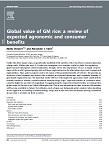 Abstract: Unlike the other major crops, no genetically modified (GM) varieties of rice have been commercialized at a large scale. Within the next 2-3 years new transgenic rice varieties could be ready for regulatory approval and subsequent commercialization, though. Given the importance of rice as staple crop for many of the world’s poorest people, this will have implications for the alleviation of poverty, hunger and malnutrition. Thus, policy-makers need to be aware of the potential benefits of GM rice. We provide an overview of the literature and discuss the evidence on expected agronomic and consumer benefits of genetically engineered rice. We find that while GM rice with improved agronomic traits could deliver benefits similar to already commercialized biotechnology crops, expected benefits of consumer traits could be higher by an order of magnitude. By aggregating the expected annual benefits, we estimate the global value of GM rice to be US$64 billion per year. This is only an indicative value, as more GM varieties will become available in future. Nevertheless, such a figure can help guide policy-makers when deciding on the approval or funding of biotechnology crops and it may also raise awareness among consumers about what is at stake for their societies. (Keywords: genetic engineering, crop biotechnology, impact, Bt rice, golden rice, biofortification.)
Abstract: Unlike the other major crops, no genetically modified (GM) varieties of rice have been commercialized at a large scale. Within the next 2-3 years new transgenic rice varieties could be ready for regulatory approval and subsequent commercialization, though. Given the importance of rice as staple crop for many of the world’s poorest people, this will have implications for the alleviation of poverty, hunger and malnutrition. Thus, policy-makers need to be aware of the potential benefits of GM rice. We provide an overview of the literature and discuss the evidence on expected agronomic and consumer benefits of genetically engineered rice. We find that while GM rice with improved agronomic traits could deliver benefits similar to already commercialized biotechnology crops, expected benefits of consumer traits could be higher by an order of magnitude. By aggregating the expected annual benefits, we estimate the global value of GM rice to be US$64 billion per year. This is only an indicative value, as more GM varieties will become available in future. Nevertheless, such a figure can help guide policy-makers when deciding on the approval or funding of biotechnology crops and it may also raise awareness among consumers about what is at stake for their societies. (Keywords: genetic engineering, crop biotechnology, impact, Bt rice, golden rice, biofortification.)
- Stein A.J., Sachdev H.P.S., Qaim M. (2008). "Genetic engineering for the poor:
Golden Rice
and public health in India." World Development
36(1): 144-158 . doi:10.1016/j.worlddev.2007.02.013 .
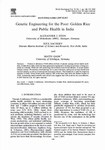 Abstract: Vitamin A deficiency (VAD) affects millions of people, causing serious health problems. Golden Rice (GR), which has been genetically engineered to produce beta-carotene, is being proposed as a remedy. While this new technology has aroused controversial debates, its actual impact remains unclear. We develop a methodology for ex ante evaluation, taking into account health and nutrition details, as well as socioeconomic and policy factors. The framework is used for empirical analyses in India. Given broad public support, GR could more than halve the disease burden of VAD. Juxtaposing health benefits and overall costs suggests that GR could be very cost-effective. (Keywords: vitamin A deficiency, biofortification, Golden Rice, disability-adjusted life years, cost-effectiveness, India.)
Abstract: Vitamin A deficiency (VAD) affects millions of people, causing serious health problems. Golden Rice (GR), which has been genetically engineered to produce beta-carotene, is being proposed as a remedy. While this new technology has aroused controversial debates, its actual impact remains unclear. We develop a methodology for ex ante evaluation, taking into account health and nutrition details, as well as socioeconomic and policy factors. The framework is used for empirical analyses in India. Given broad public support, GR could more than halve the disease burden of VAD. Juxtaposing health benefits and overall costs suggests that GR could be very cost-effective. (Keywords: vitamin A deficiency, biofortification, Golden Rice, disability-adjusted life years, cost-effectiveness, India.)
- Qaim M., Stein A.J. (2008). "Economic consequences of Golden Rice."
Invited presentation at the 4th Conference of the European Plant Science Organisation (EPSO),
22-26 June , Toulon, France.
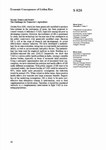 Abstract: Golden Rice (GR), which has been genetically modified to produce beta-carotene in the endosperm of grain, has been proposed to control vitamin A deficiency (VAD), especially among the poor in developing countries. However, the usefulness of GR is questioned by some, and the technology has become one of the centerpieces in the public controversy over genetically modified crops [...] we show that VAD is a serious public health problem in India, causing a sizeable disease burden, especially in terms of increased child mortality [...] if GR were to be consumed widely, the disease burden of VAD could be reduced by 60% [...] Regardless of the underlying assumptions, GR is likely to be more cost-effective than alternative vitamin A interventions, such as food supplementation or fortification. Therefore, it should be considered seriously as a complementary intervention to fight VAD in rice-eating populations.
Abstract: Golden Rice (GR), which has been genetically modified to produce beta-carotene in the endosperm of grain, has been proposed to control vitamin A deficiency (VAD), especially among the poor in developing countries. However, the usefulness of GR is questioned by some, and the technology has become one of the centerpieces in the public controversy over genetically modified crops [...] we show that VAD is a serious public health problem in India, causing a sizeable disease burden, especially in terms of increased child mortality [...] if GR were to be consumed widely, the disease burden of VAD could be reduced by 60% [...] Regardless of the underlying assumptions, GR is likely to be more cost-effective than alternative vitamin A interventions, such as food supplementation or fortification. Therefore, it should be considered seriously as a complementary intervention to fight VAD in rice-eating populations.
- Stein A.J., Sachdev H.P.S., Qaim M. (2007). "What we know and don't know about
Golden Rice." Nature Biotechnology
25(6): 624. doi:10.1038/nbt0607-624a , incl. a point-by-point refutation of arguments made against Golden Rice in response to our earlier study, and incl. an illustration of how such arguments are inconsistent and based on double standards.
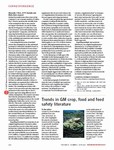 Abstract: Michael Krawinkel raises three issues in his comment to our economic analysis of Golden Rice. First, he questions the scientific basis of the assumptions that we have used in our impact assessment. Second, he claims that the development of Golden Rice costs “a lot of money” and would mainly benefit “agrochemistry” companies. And third, he states that biofortification in general and Golden Rice in particular cannot replace any of the established micronutrient interventions for the forseeable future. [... In response, we highlight the biomedical foundation and the available evidence for our assumptions; we put the costs of Golden Rice into perspective by citing the costs for alternative interventions, which are two orders of magnitudes bigger; we clarify the misconception that private companies would benefit from Golden Rice, which is a humanitarian undertaking; and more generally we illustrate how Krawinkel uses double standards in his criticism e.g. by stressing the costs of Golden Rice while ignoring the costs of other interventions, or by stressing the limitations of Golden Rice without acknowledging the shortcomings of alternative interventions (which Golden Rice could complement in a sensible way. Finally, we explain how our cost-effectiveness analysis, which uses uniform standards that create a level playing field and allow comparisons across interventions in a transparent and consistent way, represent a more objective and science-based approach.]
Abstract: Michael Krawinkel raises three issues in his comment to our economic analysis of Golden Rice. First, he questions the scientific basis of the assumptions that we have used in our impact assessment. Second, he claims that the development of Golden Rice costs “a lot of money” and would mainly benefit “agrochemistry” companies. And third, he states that biofortification in general and Golden Rice in particular cannot replace any of the established micronutrient interventions for the forseeable future. [... In response, we highlight the biomedical foundation and the available evidence for our assumptions; we put the costs of Golden Rice into perspective by citing the costs for alternative interventions, which are two orders of magnitudes bigger; we clarify the misconception that private companies would benefit from Golden Rice, which is a humanitarian undertaking; and more generally we illustrate how Krawinkel uses double standards in his criticism e.g. by stressing the costs of Golden Rice while ignoring the costs of other interventions, or by stressing the limitations of Golden Rice without acknowledging the shortcomings of alternative interventions (which Golden Rice could complement in a sensible way. Finally, we explain how our cost-effectiveness analysis, which uses uniform standards that create a level playing field and allow comparisons across interventions in a transparent and consistent way, represent a more objective and science-based approach.]
- Stein A.J., Sachdev H.P.S., Qaim M. (2006). "Potential impact and cost-effectiveness of
Golden Rice." Nature Biotechnology
24(10): 1200-1201. doi:10.1038/nbt1006-1200b. With supplementary information.
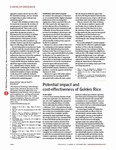 Abstract: A News & Views article by Michael Grusak in last year’s April issue (Nat. Biotechnol. 23, 429-430, 2005) highlighted the unresolved debate concerning the efficacy of Golden Rice in addressing the problem of vitamin A deficiency (VAD). He pointed out that an assessment of the potential impact of Golden Rice on this type of malnutrition requires the consideration of multiple variables, including the target individuals’ life stages, the average amount of rice consumed daily by these individuals and the percentage of β-carotene that would be absorbed from rice. He further explains how early critics of the original Golden Rice technology had used simple estimates of these variables to suggest that unrealistic amounts of the transgenic rice would need to be consumed to satisfy the recommended dietary intakes of vitamin A equivalents (exclusively) through rice consumption. [...]
Abstract: A News & Views article by Michael Grusak in last year’s April issue (Nat. Biotechnol. 23, 429-430, 2005) highlighted the unresolved debate concerning the efficacy of Golden Rice in addressing the problem of vitamin A deficiency (VAD). He pointed out that an assessment of the potential impact of Golden Rice on this type of malnutrition requires the consideration of multiple variables, including the target individuals’ life stages, the average amount of rice consumed daily by these individuals and the percentage of β-carotene that would be absorbed from rice. He further explains how early critics of the original Golden Rice technology had used simple estimates of these variables to suggest that unrealistic amounts of the transgenic rice would need to be consumed to satisfy the recommended dietary intakes of vitamin A equivalents (exclusively) through rice consumption. [...]
- Stein A.J., Sachdev H.P.S., Qaim M. (2006). "Potential impact and
cost-effectiveness of Golden Rice." Nature Biotechnology 24(10): online supplement, on p. 27 incl. a detailed point-by-point refutation of the populistic arguments made against Golden Rice in "The Golden Rice hoax."
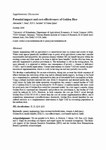 Abstract: Genetic engineering (GE) in agriculture is a controversial topic in science and society at large. While some oppose genetically modified crops as proxy of an agricultural system they
consider unsustainable and inequitable, the question remains whether GE can benefit the poor within the existing system and what needs to be done to deliver these benefits? Golden Rice has been genetically engineered to produce provitamin A. The technology is still in the testing phase, but, once released, it is expected to address one consequence of poverty – vitamin A deficiency (VAD) – and its health implications. Current interventions to combat VAD rely mainly on pharmaceutical supplementation, which is costly in the long run and only partially successful. We develop a methodology for ex-ante evaluation, taking into account the whole sequence of effects between the cultivation of the crop and its ultimate health impacts. In doing so we build on a comprehensive, nationally representative data set of household food consumption in India. Using a refined disability-adjusted life year (DALY) framework and detailed health data, this study shows for India that under optimistic assumptions this country's annual burden of VAD of 2.3 million DALYs lost can be reduced by 59.4% hence 1.4 million healthy life years could be saved each year if Golden Rice would be consumed widely. In a low impact scenario, where Golden Rice is consumed less frequently and produces less provitamin A, the burden of VAD could be reduced by 8.8%. However, in both scenarios the cost per DALY saved through Golden Rice (US$3.06-19.40) is lower than the cost of current supplementation efforts, and it outperforms international cost-effectiveness thresholds. Golden Rice should therefore be considered seriously as a complementary intervention to fight VAD in rice-eating populations in the medium term. Plus, on p. 27, incl. a detailed point-by-point refutation of the populistic arguments made against Golden Rice in "The Golden Rice hoax." (Keywords: genetic engineering, beta-carotene biofortification, vitamin A deficiency, Golden Rice, health benefits, DALYs, cost-effectiveness, cost-benefit analysis, India.)
Abstract: Genetic engineering (GE) in agriculture is a controversial topic in science and society at large. While some oppose genetically modified crops as proxy of an agricultural system they
consider unsustainable and inequitable, the question remains whether GE can benefit the poor within the existing system and what needs to be done to deliver these benefits? Golden Rice has been genetically engineered to produce provitamin A. The technology is still in the testing phase, but, once released, it is expected to address one consequence of poverty – vitamin A deficiency (VAD) – and its health implications. Current interventions to combat VAD rely mainly on pharmaceutical supplementation, which is costly in the long run and only partially successful. We develop a methodology for ex-ante evaluation, taking into account the whole sequence of effects between the cultivation of the crop and its ultimate health impacts. In doing so we build on a comprehensive, nationally representative data set of household food consumption in India. Using a refined disability-adjusted life year (DALY) framework and detailed health data, this study shows for India that under optimistic assumptions this country's annual burden of VAD of 2.3 million DALYs lost can be reduced by 59.4% hence 1.4 million healthy life years could be saved each year if Golden Rice would be consumed widely. In a low impact scenario, where Golden Rice is consumed less frequently and produces less provitamin A, the burden of VAD could be reduced by 8.8%. However, in both scenarios the cost per DALY saved through Golden Rice (US$3.06-19.40) is lower than the cost of current supplementation efforts, and it outperforms international cost-effectiveness thresholds. Golden Rice should therefore be considered seriously as a complementary intervention to fight VAD in rice-eating populations in the medium term. Plus, on p. 27, incl. a detailed point-by-point refutation of the populistic arguments made against Golden Rice in "The Golden Rice hoax." (Keywords: genetic engineering, beta-carotene biofortification, vitamin A deficiency, Golden Rice, health benefits, DALYs, cost-effectiveness, cost-benefit analysis, India.)
- Stein A.J., Sachdev H.P.S., Qaim M. (2006). "Can genetic engineering for the poor pay off?
An ex-ante evaluation of Golden Rice in India." Research in Development Economics and Policy 5, University of Hohenheim.
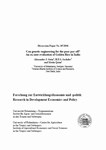 Abstract: Genetic engineering (GE) in agriculture is a controversial topic in science and society at large. While some oppose genetically modified crops as proxy of an agricultural system they consider unsustainable and inequitable, the question remains whether GE can benefit the poor within the existing system and what needs to be done to deliver these benefits? Golden Rice has
been genetically engineered to produce provitamin A. The technology is still in the testing phase, but, once released, it is expected to address one consequence of poverty – vitamin A deficiency (VAD) – and its health implications. Current interventions to combat VAD rely mainly on pharmaceutical supplementation, which is costly in the long run and only partially successful. We develop a methodology for ex-ante evaluation, taking into account the whole sequence of effects between the cultivation of the crop and its ultimate health impacts. In doing so we build on a comprehensive, nationally representative data set of household food consumption in India. Using a refined disability-adjusted life year (DALY) framework and detailed health data, this study shows for India that under optimistic assumptions this country’s annual burden of VAD of 2.3 million DALYs lost can be reduced by 59.4% hence 1.4 million healthy life years could be saved each year if Golden Rice would be consumed widely. In a low impact scenario, where Golden Rice is consumed less frequently and produces less provitamin A, the burden of VAD could be reduced by 8.8%. However, in both scenarios the cost per DALY saved through Golden Rice (US$ 3.06-19.40) is lower than the cost of current supplementation efforts, and it outperforms international cost-effectiveness thresholds. Golden Rice should therefore be considered seriously as a complementary intervention to fight VAD in rice-eating populations in the medium term. (Inclusive of a scientific appraisal of the populistic arguments gathered by Vandana Shiva in "The 'Golden Rice' hoax" - which are, for instance, more widely circulated and exploited by Greenpeace.) (Keywords: genetic engineering, beta-carotene biofortification, vitamin A deficiency, Golden Rice, health benefits, DALYs, cost-effectiveness, cost-benefit analysis, India.)
Abstract: Genetic engineering (GE) in agriculture is a controversial topic in science and society at large. While some oppose genetically modified crops as proxy of an agricultural system they consider unsustainable and inequitable, the question remains whether GE can benefit the poor within the existing system and what needs to be done to deliver these benefits? Golden Rice has
been genetically engineered to produce provitamin A. The technology is still in the testing phase, but, once released, it is expected to address one consequence of poverty – vitamin A deficiency (VAD) – and its health implications. Current interventions to combat VAD rely mainly on pharmaceutical supplementation, which is costly in the long run and only partially successful. We develop a methodology for ex-ante evaluation, taking into account the whole sequence of effects between the cultivation of the crop and its ultimate health impacts. In doing so we build on a comprehensive, nationally representative data set of household food consumption in India. Using a refined disability-adjusted life year (DALY) framework and detailed health data, this study shows for India that under optimistic assumptions this country’s annual burden of VAD of 2.3 million DALYs lost can be reduced by 59.4% hence 1.4 million healthy life years could be saved each year if Golden Rice would be consumed widely. In a low impact scenario, where Golden Rice is consumed less frequently and produces less provitamin A, the burden of VAD could be reduced by 8.8%. However, in both scenarios the cost per DALY saved through Golden Rice (US$ 3.06-19.40) is lower than the cost of current supplementation efforts, and it outperforms international cost-effectiveness thresholds. Golden Rice should therefore be considered seriously as a complementary intervention to fight VAD in rice-eating populations in the medium term. (Inclusive of a scientific appraisal of the populistic arguments gathered by Vandana Shiva in "The 'Golden Rice' hoax" - which are, for instance, more widely circulated and exploited by Greenpeace.) (Keywords: genetic engineering, beta-carotene biofortification, vitamin A deficiency, Golden Rice, health benefits, DALYs, cost-effectiveness, cost-benefit analysis, India.)
- Stein A.J., Sachdev H.P.S., Qaim M. (2006). "Potential impacts of
Golden Rice
on public health in India." Contributed paper presented at the 26th Conference
of the International Association of Agricultural Economists (IAAE),
August 12-18 , Broadbeach, Australia.
Presentation on Golden Rice [PDF | 54KB].
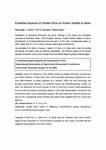 Abstract: Vitamin A deficiency (VAD) affects millions of people world-wide, causing serious health problems. Golden Rice (GR), which has been genetically engineered to produce beta-carotene, is being proposed as a remedy. While this new technology has aroused controversial debates, its nutritional impact and cost-effectiveness remain unclear. We determine the current burden of VAD in India from a public health perspective, and simulate the potential alleviating impact of GR using representative household food consumption data. Given broad public support, GR could more than halve the overall burden of VAD. Juxtaposing health benefits and overall costs suggests that GR is very costeffective. (Keywords: Golden Rice, vitamin A deficiency, biofortification, genetic engineering, DALYs, cost-effectiveness analysis, India.)
Abstract: Vitamin A deficiency (VAD) affects millions of people world-wide, causing serious health problems. Golden Rice (GR), which has been genetically engineered to produce beta-carotene, is being proposed as a remedy. While this new technology has aroused controversial debates, its nutritional impact and cost-effectiveness remain unclear. We determine the current burden of VAD in India from a public health perspective, and simulate the potential alleviating impact of GR using representative household food consumption data. Given broad public support, GR could more than halve the overall burden of VAD. Juxtaposing health benefits and overall costs suggests that GR is very costeffective. (Keywords: Golden Rice, vitamin A deficiency, biofortification, genetic engineering, DALYs, cost-effectiveness analysis, India.)
- Stein A.J. (2006). "Potential impact and cost-effectiveness of Golden Rice in India:
an ex-ante study ." Invited presentation at the Meeting of the Golden Rice Humanitarian Board, May 2, Freiburg i.Br., Germany.
Presentation on Golden Rice [PDF | 113KB].